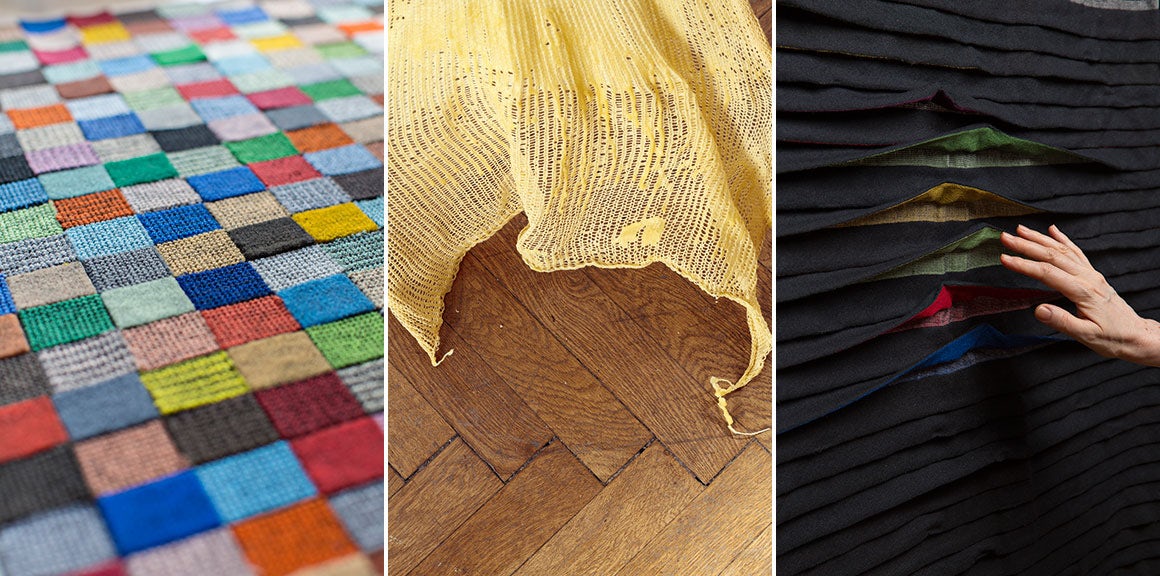Artists and craftworkers at the original Bauhaus school, like first female master Gunta Stölzl,helped turn the weaving workshop into one of the most successful and renowned departments. Stölzl was famous for combining traditional techniques with new art forms to make innovations, and today’s textile students at the Burg Giebichenstein Kunsthochschule Halle have continued those practices into the 21st century. To celebrate these students’ works and the Burg School’s centenary, the Bauhaus-Archiv / Museum für Gestaltung in Berlin has today opened a new exhibition, “Textile Design Today: From Experiment to Series.”

From left: LCS Perlon pattern by Anker Teppich, photo by Matthias Ritzmann; knit by Julia Kortus, photo by Armen Asatryan; woven fabric with folds and motion sensors by Manuela Leite, photo by Matthias Ritzmann
“Burg Giebichenstein and the Bauhaus were very closely related in terms of content, and there were lively exchanges between them,” says Annemarie Jaeggi, Director of the Bauhaus-Archiv / Museum für Gestaltung. “And the Burg is still continuing this tradition today.” The exhibition, curated by Bettina Göttke-Krogmann, will show off this connection through experimental work from the textiles course at Burg that reexamines color, material and responsible production methods. At the same time, projects from well-known designers and brands like Freitag, Kvadrat and Creation Baumann will reinforce the impact new textiles have on fashion, interior design and, even, architecture.

From left:basket-like cloak for Philip Treacy by Moritz Waldemeyer, photo by Moritz Waldemeyer; ikat technique by Annegret Lembcke
Arranged into sections of Tradition, Cultural Transfer, Smart Textiles and Sustainability, works show off how Burg students explore aesthetics, practicality and identity in their textiles. Their projects look both backward and forward to find bold visuals and new design solutions, mixing ancient techniques with advanced technology and contemporary production methods. Yarn made from unlikely materials like milk and beeswax will be on display alongside fabrics created with recycled plastic and by 3D printing.
Among some of the standout projects in this wide range are Manuela Leite’s interactive woven curtains. Activated by motion sensors, they unfold and shut based on movement to reveal splashes of color and offer an exciting new use of technology for aesthetics. Along the same lines, Moritz Waldemeyer’s basket cloak for Philip Treacy merges exaggerated silhouettes and lighting design with fashion. While at the opposite end of the spectrum, projects like Annegret Lembcke’s ikatweaving brings an almost-forgotten technique from Aleppo into a new, modern context.

From left: bag made from 10 thermally pressed fruit bags by Stefanie Brendel, photo by Anna Eckolt; Pinifère Profonde finished veneer with reactive dye, photo by Josefine Düring; Farce double by Josefine Düring, photo by Josefine Düring; Colourful Creatures by Uta Tischendorf, photo by Uta Tischendorf
These and numerous other innovative works will be on display through September 5, 2016. Visitors can also look for corresponding special events like the upcoming Bauhaus Brunch and lectures that celebrate the Burg school. A 248-page exhibition catalog is also set for publication in English and German.









